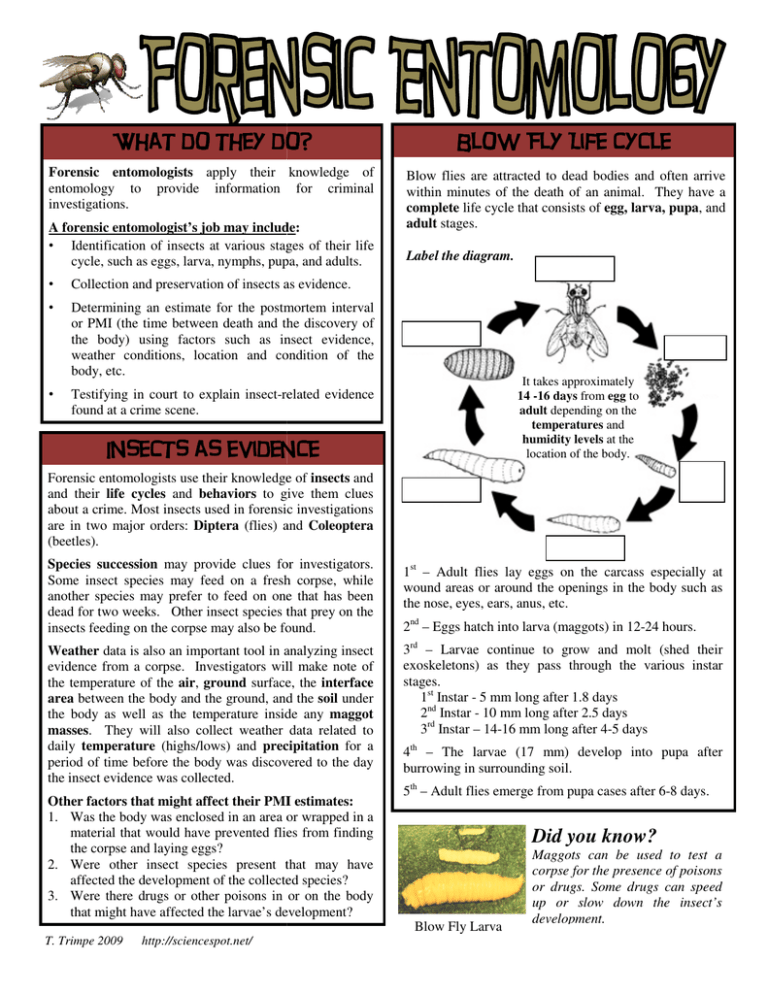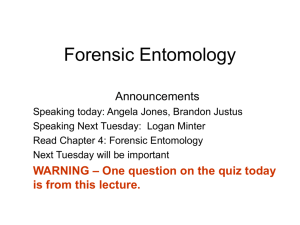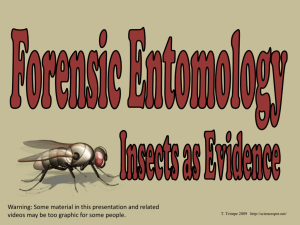What do they do? Insects as evidence Blow Fly
advertisement

What do they do? Blow Fly Life Cycle Forensic entomologists apply their knowledge of entomology to provide information for criminal investigations. Blow flies are attracted to dead bodies and often arrive within minutes of the death of an animal. They have a complete life cycle that consists of egg, larva, pupa, and adult stages. A forensic entomologist’s job may include include: • Identification of insects at various stages of their life cycle, such as eggs, larva, nymphs, pupa, and adults. • Collection and preservation of insects as evidence. • Determining an estimate for the postmortem interval or PMI (the time between death and the discovery of the body) using factors such as insect evidence, weather conditions, location and condition of the body, etc. • Testifying in court to explain insect-related related evidence found at a crime scene. Label the diagram. It takes approximately 14 -16 days from egg to adult depending on the temperatures and humidity levels at the location of the body. Insects as evidence Forensic entomologists use their knowledge of insects and and their life cycles and behaviors to give them clues about a crime. Most insects used in forensic investigations are in two major orders: Diptera (flies) and Coleoptera (beetles). Species succession may provide clues for investigators. Some insect species may feed on a fresh corpse, while another species may prefer to feed on one that has been dead for two weeks. Other ther insect species that prey on the insects feeding on the corpse may also be found found. 1st – Adult flies lay eggs on the carcass especially at wound areas or around the openings in the body such as the nose, eyes, ears, anus, etc. Weather data is also an important tool in analyzing insect evidence from a corpse. Investigators will make note of the temperature of the air, ground surface, the interface area between the body and the ground, and the soil under the body as well as the he temperature inside any maggot masses.. They will also collect weather data related to daily temperature (highs/lows) and precipitation for a period of time before the body was discovered to the day the insect evidence was collected. 3rd – Larvae continue to grow and molt (shed their exoskeletons)) as they pass through the various instar stages. 1st Instar - 5 mm long after 1.8 days 2nd Instar - 10 mm long after 2.5 days 3rd Instar – 14-16 mm long ong after 4-5 days Other factors that might affect their PMI estimates: 1. Was the body was enclosed in an area or wrapped in a material that would have prevented flies from finding the corpse and laying eggs? 2. Were other insect species present that may have affected the development of the collected species? 3. Were there drugs or other poisons in or on the body that might have affected the larvae’s development? 2nd – Eggs hatch into larva (maggots) in 12-24 12 hours. 4th – The larvae (17 mm) develop into pupa after burrowing in surrounding soil. 5th – Adult flies emerge from pupa cases after 6-8 days. Did you know? Blow Fly Larva T. Trimpe 2009 http://sciencespot.net/ Maggots can be used to test a corpse for the presence of poisons or drugs. drug Some drugs can speed up or slow down the insect’s development. Examples of Diptera Early Stage Decomposition Examples of Coleoptera Early Stage Decomposition Early to Late Stage Decomposition Late Stage Decomposition Late Stage Decomposition Did you know? The “Body Farm” in Knoxville, Tennessee is a university research facility to investigate human decomposition under various conditions in order to understand the factors which affect its rate. T. Trimpe 2009 http://sciencespot.net/ Source: http://agspsrv34.agric.wa.gov.au/ento/_fpclass/forensic21.jpg


